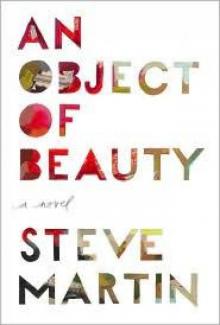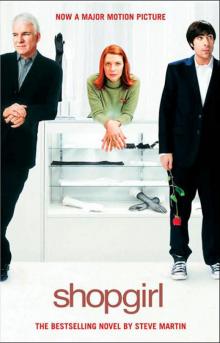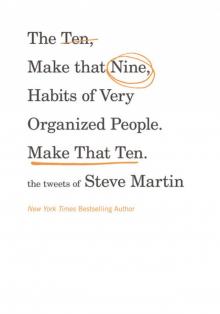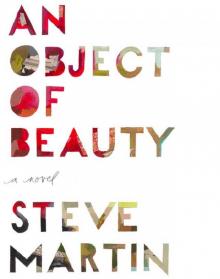- Home
- STEVE MARTIN
An Object of Beauty Page 2
An Object of Beauty Read online
Page 2
The contemporary art scene was the left bank suburb to Lacey’s right bank, uptown art world. Her connection to it was the numerous young hyphenates that would drift across the barroom floors: artist-house painter, artist-art mover, artist-musician. One of her favorites, Jonah Marsh, had a rarer label, artist-deejay. He could be a good artist but made paintings that no matter how much he changed them or developed them still looked derivative of someone better. However, as a deejay, he was very, very cute. One night at a bar, he was circling around Lacey, trying to appear smart, funny, impetuous, raucous, pathetic, anything to get her in bed, that night, now. Lacey, giving in, said to him, “Look, I just want to get off.” They went to her place and afterward he conveniently said, “I have to get up early,” and left, to Lacey’s relief.
3.
ONE TUESDAY, near starvation caused Lacey to finally splurge in the Sotheby’s lunchroom, a smartly done, packaged-sandwich place with Formica tables and uptown prices. Here, the staff mingled with the department heads and Lacey could easily discern one class from the other based on thread count. The department heads were usually less alluring than the staff, since they were hired on expertise, not glamour, and they were usually less haggard than the tireless employees who were sent running from floor to floor. At one table was Cherry Finch, head of American Paintings, while at another was Heath Acosta, head of European Paintings and natty in a gray suit and tie, sitting with an obvious client. Obvious because of his black hair that hung in short ringlets and was laden with product. His Mediterranean skin and open silk shirt said clearly that he was not an employee. He was mid-thirties, foreign, and handsome enough that Lacey’s inner critic did not object to his playboy rags.
With regularity, the client’s eyes strayed to Lacey. Lacey ate more and more slowly, trying to stop the clock before she had no further excuse to stay. Eventually, when their check was paid, Acosta and the client made a deliberate move to her table.
“Hello, I’ve seen you, but we haven’t met. I’m Heath Acosta, from European Paintings.”
“Well then, you’re like everyone in the company: my superior. I’m Lacey Yeager. I work down in Hades.”
“Ah, the bins.”
“Hence my lack of tan.”
The client lurched in: “Better than leather skin at forty. Hello, I’m Patrice Claire.” His face was a bottle bronze, and his French accent surprised Lacey; she was expecting Middle Eastern. “Do you enjoy European painting?”
“I’m sure I will one day,” Lacey said.
“Maybe you haven’t seen the right ones,” said Patrice. Then to Acosta, “It’s unfair that you separate the Impressionists into their own group. Aren’t they Europeans?”
Acosta replied, “Impressionists aren’t tidy enough for our European collectors.”
“Well then, they wouldn’t like me, either,” said Lacey. Patrice’s face signaled the opposite.
“Have you been to an auction yet?” said Acosta.
“I didn’t know if I was allowed…”
“Come to the European sale next week,” he said. “Ten a.m. Thursday. We can excuse you from Hades that day.”
“Do I need to get there early for a seat?” said Lacey.
“Heavens, no, not for European. The recession has seen to that.”
Acosta turned to go, and Patrice added, “Be sure not to cough, sneeze, or scratch.”
She had no doubt that the visit to the table was at Patrice’s request, to make contact and take a closer look. Lacey gave him a look back that said she was fuckable, but not without a bit of work.
4.
THURSDAY MORNING, Lacey slipped into one of the folding chairs at the European sale. The hall was half-full, and the rumored excitement of a live auction was belied with every tired raise of a paddle, followed by bidders’ early exits. The art market had collapsed a few years ago and was still sputtering. By 1990 the boom had withered, but before that date, carloads of inferior French paintings had been sold to the Japanese and then hurriedly crated and shipped overseas before the buyers realized that perhaps their eye for Impressionism had not been fully developed. Sotheby’s, Christie’s, and dealers along Madison Avenue had found a repository for their second- and third-best pictures, and they all feared the moment when the Japanese would decide to sell the gray Pissarros and the fluffy, puffy Renoirs—proudly hung in Japanese department stores to impress their customers—and recognize that they had been had. Thankfully, an art market crash gave the dealers an excuse to avoid urgent pleas for buybacks when the Japanese would discover just how bad were the pictures they had been sold: “Oh, the economy has just collapsed!”
Lacey watched the auction unfold and wondered how people could afford twenty thousand dollars to buy a sketch by an unfamiliar Spaniard with three names. She watched Heath Acosta on the sideline, beaming, but she couldn’t figure out what he was beaming about. Every other picture remained unsold. He was probably trying to put a brave face on the crashing sale. She watched as pictures she had grown fond of downstairs stiffed in front of the sullen crowd, meaning they would be returned downstairs, where they would wait for their disappointed owners to claim them.
La Mondaine, James Tissot, 1883-1885
58.3 x 40.5 in.
Next up was James Jacques Joseph Tissot’s picture of a theater lobby filling up just after the curtain call. Men in opera hats steer their young femmes toward the exit; the women wear lavish dresses, sport hats that cost as much as carriages, and swim under billows of fur. Tissot was the master of a small subject—the rich—and he swathed the women in yards of fabric and painted them midflounce as they disembarked from boats, lounged in parks, or sat on window seats overlooking the sea.
The estimate on the Tissot was five hundred thousand to seven hundred thousand. There was a small stir when the rotating display brought it into view; it looked good. If it stalled, it would be hard for Acosta to maintain his plastered beam. The picture started off at three hundred fifty thousand, and no paddles were raised. Acosta seemed unfazed. He scanned the room, then nodded, and the auctioneer called out, “I have three hundred fifty thousand.” Soon, four hundred thousand. Then, four hundred fifty thousand. Then the auctioneer took a leap: no more fifty-thousand-dollar increments. Six hundred thousand. Seven hundred thousand. The picture crossed a million, then a million five, and then once again in fifty-thousand-dollar increments, finally selling at two million dollars.
Was this a one-off, or was the art recession loosening? Was Acosta smiling because he had known of secret bids aimed at the Tissot? Auctioneers often knew in advance what someone was willing to bid. Lacey noticed that as the pace of the bids picked up, she felt a concomitant quickening of her pulse, as though she had been incised by an aphrodisiacal ray.
That evening she called Jonah Marsh, the cute deejay, and met him late night at MoMA. They walked around and looked at paintings until she had recharged the morning’s ardor, finally taking him home with her. After sexual due process—an outbreak of inhibition, contortion, flying words, and sweat with fair exchanges on both sides—Jonah groggily left, again relieving Lacey of the burden of postcoital chat. She sipped port and stared out her window, a window still grimy with the residue of winter, and relived the auction earlier that day. One million, one million five… two million. Someone had just cashed in grandly, unexpectedly. It made her wonder: Could she make money in art, Tissot money?
At Sotheby’s, she started to look at paintings differently. She became an efficient computer of values. The endless stream of pictures that passed through the auction house helped her develop a calculus of worth. Auction records were available in the Sotheby’s library, and when a picture of note came in, she diligently searched the Art Price Index to see if it had auction history. She factored in condition, size, and subject matter. A Renoir of a young girl, she had witnessed, was worth more than one of an old woman. An American western picture with five tepees was worth more than a painting with one tepee. If a picture had been on the market recently with
out a sale, she knew it would be less desirable. A deserted painting scared buyers. Why did no one want it? In the trade, it was known as being “burned.” Once a picture was burned, the owner had to either drastically reduce the price or sit on it for another seven years until it faded from memory. When Lacey began these computations, her toe crossed ground from which it is difficult to return: she started converting objects of beauty into objects of value.
5.
LACEY KNEW I was coming uptown and insisted I stop by Sotheby’s for lunch. She had something to show me, she said. I met her at the Sotheby’s sandwich bar, and we snagged a sunny corner table.
“Do you want to see a picture of my grandmother?” asked Lacey.
“Is this a trick question?” I said.
She reached into her wide-mouth purse and withdrew a very used art book covered with library acetate and bearing a small, rectangular label with what looked like a Dewey Decimal System number and a second label that clearly, seriously said, “Property of Sotheby’s.” She handled the book so freely in the lunchroom that I knew it had been legitimately checked out of the library and did not represent a heist.
“Remember when I told you I was related to the arts?”
“Well, no, but go on.”
“My grandmother is Kitty Owen.”
Lacey laid the book on the table and spun its face toward me. On the cover was a painting by Maxfield Parrish. I knew a bit about him. In the twenties, he was America’s most famous artist. His pictures featured young girls lounging by lakes or sitting naked on tree swings in fanciful arcadias. These delicately painted pictures also sold tires and magazines. Logos were emblazoned across reproductions on calendars and posters, sometimes painted into the work itself. Parrish hovered between being an illustrator and an artist.
Daybreak, Maxfield Parrish, 1922
26.5 x 45.5 in.
Lacey poked her finger down on the cover.
“That’s my grandmother,” she said. “She was eighteen when she took off all her clothes for him and posed. See, you’re not the only one with wise-ass art credentials.”
“Is she…” Alive, I was going to say.
“She’s ninety-two. She still has that skin, but the red hair is phfft.” I looked at the slender, pale girl on the cover of the book, who looked like a faun standing over an idyllic pool trimmed in iridescent tiles.
“She owns a print with her in it. He gave it to her. I checked the Sotheby’s records to see how much it was worth. Not much. Two hundred bucks. It’s our only artistic heirloom. It’s got a nice story with it.
“Kitty, Gram, had posed for a painting. She was nude, lying on a rock. Parrish had prints made. There was a stack of them on a table, and he told Kitty he wanted to give her something. Then he reached from behind the table and gave her one in a very expensive frame and under glass. Very special.”
“You think there was… involvement?” I said.
“No, Parrish went for another model. He and his wife and the model lived happily/horribly ever after. The picture has hung in our house for as long as I can remember, and sometimes, when the house was empty, I would take off all my clothes and lie on the floor and look up at the picture, dreaming that I was like her, in the most beautiful forest, stretched long, arching up, and facing the twilight. I pretended that I was in heaven.”
6.
A YEAR AND A HALF passed well. I had reviewed a small show for the Village Voice and received a complimentary note from Peter Schjeldahl, who was the main critic there at the time. Lacey was moving up at Sotheby’s, literally. Frequent paperwork kept her upstairs, and she found that newcomers, mostly young white girls just off a collegiate slave boat, were being sent down the mine shaft to replace her, staggering out of the elevator hours later with dilated eyes, happy once again to see the sun. She was kept from a significant raise on the premise that new employees were really interns learning the business, and during one of our increasingly rare lunches, she told me this: “Guess what I figured out: Sotheby’s is my yacht. It’s a money pit. I’m losing money just to work there. I can last another year and then I’m headed for whore town, which could be kind of good, depending on the outfits.”
Upstairs, information passed more freely. It came in overheard slices and tidbits, and in facial expressions, too. A sneer or sigh directed at a Picasso by one of the experts meant something, and she started to grasp why one Picasso warranted a snub while another one elicited awe. Her clothes meant more, too. Like a teen at Catholic school, she knew how to tweak the prescribed outfit with sultry modifications, the outline of her black bra under white silk, an embroidered cuff, an offbeat shoe. So, while fitting in, she was like a wicked detail standing out against a placid background.
In the glamorous world of the fourth floor, the artworks she had cataloged downstairs—the minor works of art by well-known names and the major works by unknown names—became like old high school friends: she had moved on, but they hadn’t. Oh yes, she still liked them, but when two handlers with white gloves brought in a 1914 Schiele drawing of a nude and handled it like something precious and valuable, it made the basement seem like playschool. The special treatment it received made her look closer, too. After the conservative, unimaginative dabs downstairs, Schiele’s daring teen nudes, contorted and imaginatively foreshortened, were shocking. These were not cows in a landscape. She imagined his boudoir in Vienna with its swinging door of stoned young girls spreading their legs while Schiele drew them in.
The fourth floor brought an annoyance into Lacey’s life. Tanya Ross was one year older than Lacey, had been at her job a year longer than Lacey, and had already steamed ahead in her career at Sotheby’s. She bustled around with confidence, and she always seemed to be in Lacey’s view no matter how often Lacey twisted in her chair. She was taller than Lacey; she was prettier than Lacey: a deep brunette whose trademark was efficiency. This last quality made her perfect for dealing with serious clients who expected no nonsense. Certain dour customers asked for her by name, which gave Tanya a splendid position as an up-and-comer in the company.
Lacey had a keen eye for rivals, and at one of our lunches only a week after the elevator promotion, she pronounced Tanya an “up-talking Canadian. She touts Art History 101 like it’s a PhD, but she also knows that cleavage works.” I checkmarked this comment, since Lacey was capable of an equally manipulative display of cleavage at the right time, for the right person, for the right ends.
“Maybe you have to get to know her,” I mistakenly said.
“There’s nothing there to know,” she rasped, and held up her fist as if to punch me. “They brought up a Picasso the other day, and I saw her look at the label on the back to find out who painted it. She had to look at the label. Plus she’s financed. I think her last name is Wham-o or something. Tanya Wham-o. When someone less capable is ahead of me, I am not pleased. It makes me insane.”
“Makes you insane? You already are,” I said. Then, “What if someone more capable is ahead of you?”
“That’s even worse,” she said.
This being a cool spring, Lacey’s clothes were less revealing than in the torrid summer, and she relied on fashion quirks to make up for the lost power. She buttoned up her blouse neck high, over which she had donned a child’s sweater, a size large but still too small, which clung to her and rode up three inches above her waist. The food came.
“I’m thinking of getting a dog,” she said.
“What kind?” I asked.
“One that’s near death.”
“Why?”
“Less of a commitment,” she answered.
This was Saturday. Lacey would return to work and process a few midrange pictures that were being delivered. She liked the Saturday deliveries because they were special arrangements always brought in by clients, since the art handlers only worked weekdays. Sotheby’s wasn’t a pawnshop, so the sellers usually weren’t desperate; they were just sellers. They might be a New Jersey couple who had heard about a successful sale of
an artist they owned, or people with inherited pictures, or a young man helping his elderly relatives through the hoops of a Sotheby’s contract. Pictures from Connecticut were generally overframed decorator concoctions surrounding dubiously attributed horse paintings. But pictures from New Jersey were usually the genuine article, purchased years ago from galleries or even from the artists themselves. The pictures typically bore ugly frames created by local framers who used gold paint rather than gold leaf or slathered them in a dull green or off-white substance reminiscent of caulk. One elderly couple hobbled in carting a small but sensational Milton Avery in a frame so ghastly that Cherry Finch looked at the painting with her fingers squared so as to screen it out. When Cherry told the couple the picture would be estimated at sixty to eighty thousand, the gentleman’s phantom suspenders almost popped. They had paid three hundred dollars for it in 1946, the year it was painted, and the price was still stuck to the back.
Nude Bathers, Milton Avery, 1946
25.5 x 35.5 in.
Milton Avery was an isolated figure in American painting, not falling neatly into any category. He would reduce figures and landscapes to a few broad patches of color: a big swath of black would be the sea, a big swath of yellow would be the sand, a big swath of blue would be the sky, and that would be it. His pictures were always polite, but they were polite in the way that a man with a gun might be polite: there was plenty to back up his request for attention. Though his style changed only slightly during his career, he was not formulaic, indicated by the existence of as many paintings that worked as ones that didn’t. The painting that Cherry was looking at was one that did.

 Born Standing Up: A Comic's Life
Born Standing Up: A Comic's Life An Object of Beauty
An Object of Beauty Pure Drivel
Pure Drivel Shopgirl
Shopgirl The Boys' Book 3
The Boys' Book 3 The Ten, Make That Nine, Habits of Very Organized People. Make That Ten.: The Tweets of Steve Martin
The Ten, Make That Nine, Habits of Very Organized People. Make That Ten.: The Tweets of Steve Martin An Object of Beauty: A Novel
An Object of Beauty: A Novel